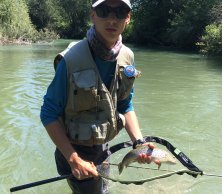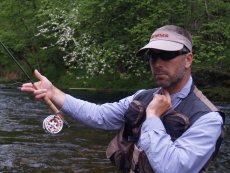Basic overview of fly fishing leaders for modern nymphing methods - Euro Nymphing, French Nymphing or Czech Nymphing.
Long soft action rods, fine tippets, brightly colored leaders and fly line that is rarely pulled out of the fly rod. Exactly on these matters is one of the youngest fly fishing techniques, which is nothing but French nymphing. It comes only from the beginning of the millennium, and it was from the hands of French competitors. In this article, I would like to answer frequently asked questions about the French nymphing leaders and tools you need for this technique. To get started with this technique we will need a suitable nymph rod, reel, thin nymphing fly line, fine tippets and a long nymph leader.
French Nymph Leaders
The most important part of our set up for French nymphing is undoubtedly a long nymphing leader, thanks to which we are able to naturally present our flies over longer distances. Nowadays, there is a large number of French nymphing leaders on the market in various lengths, colors and diameters. As with traditional fly fishing leaders, we can divide the French nymph leaders into a) tapered, b) level and c) hand-made leaders of different diameters.
Tapered French Leaders
Most often, when fishing on the French nymph, we use tapered French nymphing leaders. The biggest advantage of those leaders is the absence of knots, so it is very easy to cast with them. It is important that the leader has as little shape memory as possible and that we can see it well, because the leader also helps us to follow the strikes of the fish.
Tapered French nymph leaders are nowadays offered both in clear and in a large number of colors (including fluo colors), which significantly improve the visibility of our line-up. It should be noted that the leaders in short versions (up to about 450 cm) end with a relatively strong end of 0.50 - 0.57 mm (here I mean the upper end, which connects with the fly line) and are therefore quite heavy and when presenting small flies at a greater distance the leader is dragged by the stream and the flies go unnaturally through the water and do not manage to sink well. That is the reason why longer leaders are more suitable.
Level Leaders
Level (straight) French leaders are also fully sufficient, and when using small tungsten flies, these leaders also have one advantage in my opinion. The flies on the level leader tend to move more naturally and the leader has almost no resistance to flies. The disadvantage, however, is sometimes the tendency to tangle the leader to the tip of the rod, especially when you fish in the rain and the leader sticks more to the blank of the fly rod.
Despite this disadvantage, I like to use this type of leader and build it from a tippet with a diameter of 0.22 - 0.25 mm. A good material for the production of these French leaders is JMC Kamoufil, which was also the first leader material from the founders of this technique. You can also use some carp camou lines, special soft lines for sea fishing, or fluo lines, which are mainly used in spinning.
Hand-made Leaders
Hand-made leaders are made up of different tippet diameters and are the main two reasons why some fly fishers make their own leaders. First of all, you can tune your leaders according to your requirements in terms of length, strength or way of making the leader tapered. Secondly, a homemade leader will cost a fly fisher bit less than commercially produced leaders. The disadvantage of the hand-made leaders are the knots that make the leader more difficult to pass through the fly rod eyes. This problem can be partially solved by coating the knots with bit of glue. If you want to make the leader yourself, I can recommend for example STROFT tippet in diameters from 0.28 to 0.25 mm.
French Leader Length
All the above types of leaders coincide in length, which ranges from 360 - 900 cm, but you can also find longer ones (up to 14 m). A 900-cm leader will be the perfect leader to get you started. With such a long French leader you can also cast at long distances (in most situations we target fish at a maximum of 6 - 8 meters distance), and this is the biggest advantage of this technique over the traditional technique of Czech Nymphing, when fishing at short distances, often just below the rod tip. When using a 9 meter long French leader, we usually keep the fly line in the reel so traditional fly line is not really needed. When fishing with shorter leaders and we need to use the part of the fly line for casting or presentation of our nymphs, we need to use specialized nymphing fly line in order to keep all the advantages of French Nymphing technique.
French Leaders for competition fly fishing
International rules do not allow long French leaders to be used, maximum length of the leader is allowed to be two lengths of the fly rod. Other restrictions include the prohibition of the use of some types of strike indicators (drop, spiral, braided, etc.) and the whole assembly (fly line, leader, indicator and tippet) must gradually narrow. This means that when the leader ends with a diameter of 0.25, the indicator must be of the same or lower diameter.
So there are many limitations in competition fly fishing and the rules change frequently. Under the current rules (year 2019) the length of the leader must be about 450 cm (max 2 fly rod lengths). The nymphing fly line must have a minimum diameter of 0.55 mm. So with a short leader, you almost always throw a part of the fly line out of the rod (which is a significant difference from catching with the long leader as described above), so it is very important that the leader-to-line connection is smooth and passes well through the rod eyes well.
In the vast majority of competition fly fishers, you will not see commercially sold French nymph leaders, level or hand-made leaders prevail. The main reason is the above-mentioned high weight of leaders produced in lengths of about 450 cm. It is therefore important to adapt the leader to the weight of the flies and the equipment used and the location to be fished.
As a rule, we find that French leaders start with a diameter of 0.28 mm and end with a diameter of 0.22-0.25 mm.
In the next article we will talk about indicators for fishing with French leaders.
Tight French Leaders!

















